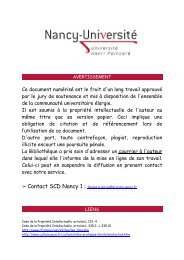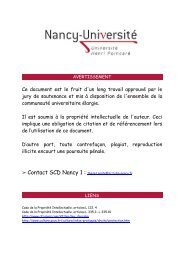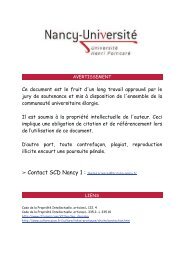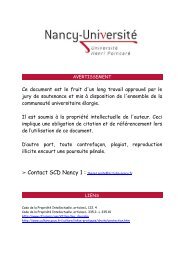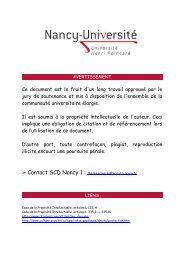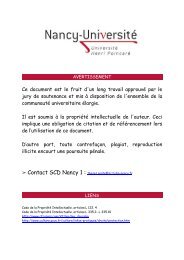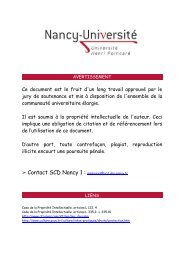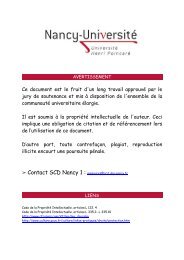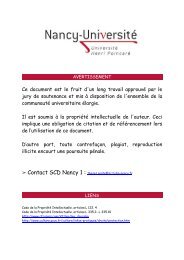Contact SCD Nancy 1 :
Contact SCD Nancy 1 :
Contact SCD Nancy 1 :
Create successful ePaper yourself
Turn your PDF publications into a flip-book with our unique Google optimized e-Paper software.
C) Interactions entre les processus attentionnels et exécutifs ........................................54<br />
VI) LES FONCTIONS EXÉCUTIVES ET LES APPRENTISSAGES ....................................................55<br />
VII) PROFIL EXÉCUTIF DE L’ENFANT PRÉSENTANT UN TDA/H .................................................56<br />
A) Le TDA/H : un « syndrome dysexécutif » ? ................................................................56<br />
1. Le modèle de Barkley (1997) ...............................................................................57<br />
2. Le modèle de Sonuga-Barke (2002) .....................................................................59<br />
B) Spécificité du déficit exécutif chez l’enfant TDA/H .....................................................59<br />
C H A P I T R E 3 - STRATEGIES D’INTERVENTION CIBLEES SUR LES FONCTIONS<br />
EXECUTIVES CHEZ LES SUJETS PRESENTANT UN TDA/H ...........................................61<br />
I) LA REMÉDIATION COGNITIVE EN NEUROPSYCHOLOGIE ........................................................61<br />
A) Définition de la remédiation cognitive ........................................................................61<br />
B) Différentes applications de la remédiation cognitive ..................................................62<br />
1. Selon la population concernée .............................................................................62<br />
2. La remédiation cognitive de l’attention chez les sujets TDA/H ..............................62<br />
C) Principes et intérêts de la remédiation cognitive ........................................................63<br />
1. Principes fondateurs .............................................................................................63<br />
2. Intérêts des programmes de remédiation cognitive ..............................................64<br />
II) LES STRATÉGIES DE RESTAURATION DITES « TOP-DOWN » ................................................65<br />
III) LES STRATÉGIES D’INTERVENTION DITES « BOTTOM-UP » .................................................68<br />
A) Programmes non informatisés .................................................................................68<br />
B) Programmes informatisés ........................................................................................69<br />
IV) LES INTERVENTIONS MULTIMODALES ...............................................................................70<br />
C H A P I T R E 4 - METHODOLOGIE ................................................................................73<br />
I) OBJECTIFS DE L’ÉTUDE ....................................................................................................73<br />
II) PRÉSENTATION DE LA POPULATION ..................................................................................73<br />
4



